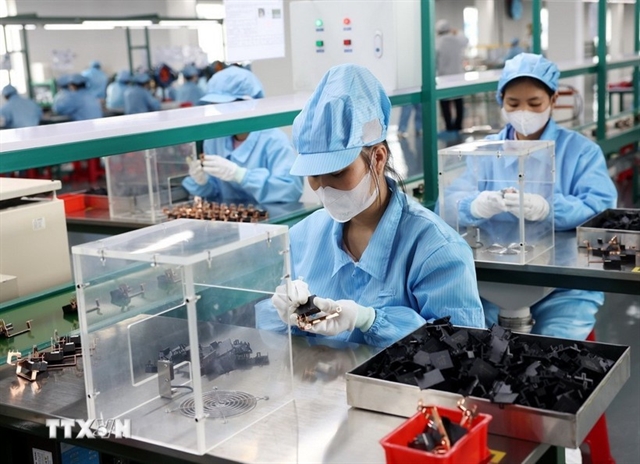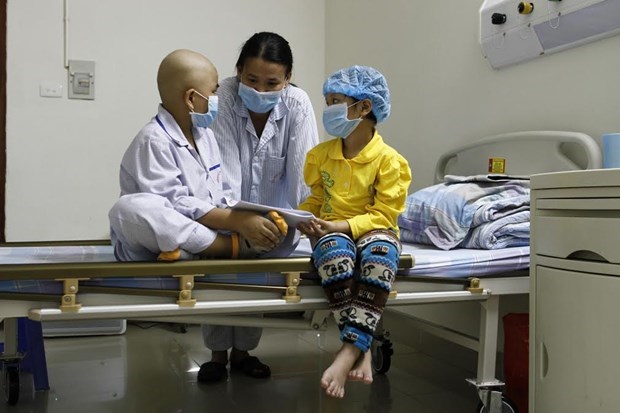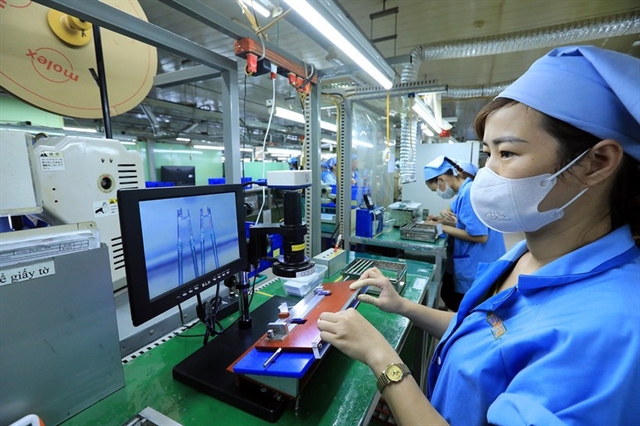 Society
Society

The institute first carried out an autologous stem cell transplant in 2006 and since then, hundreds of people have found a new life after receiving a stem cell transplant.

|
| A boy (left) was transplanted with stem cells in the National Institute of Hematology and Blood Transfusion. VNA/VNS Photo |
HÀ NỘI – Stem cell transplants have created a revolution in the treatment of blood diseases at the National Institute of Hematology and Blood Transfusion (NIHBT).
The institute first carried out an autologous stem cell transplant in 2006 and since then, hundreds of people have found a new life after receiving a stem cell transplant.
14 years ago, Dương Ngọc Chiến from central Hà Tĩnh Province discovered a large tumour in her abdomen and swelling in her armpits.
Then, she was diagnosed with blood cancer.
The 15-year-old girl with many dreams and ambitions was devastated.
Her youth became the days of tears and pain, revolving around hospitals, medicine and needles.
After seven years of drug treatment, Chiến's illness became more and more serious. She vomited constantly and was unable to eat or drink. The young girl became emaciated.
At the age of 22, Chiến was offered a stem cell transplant operation. If the transplant was successful, she would be healthy but if her body rejected the transplanted cells, she faced the worst-case scenario.
After many days of thinking, she chose to receive stem cells donated by her brother.
After the transplant, the young girl vomited blood. Her body was exhausted. After four months, the cancer was still in her blood.
Chiến completely collapsed and thought she would die soon.
But thinking about the amount of money her family borrowed to save her life, she tried to fight the disease every day.
Luck finally smiled on her and in the fifth month, her test indicators got better. She gradually recovered and has had a healthy, normal life for the past seven years.
Now, she is married and has a bright future ahead of her.
Unlike Chiến, three-year-old boy Phạm Nguyên Hà in Hà Nội had to undergo three stem cell transplants as well as long-term chemotherapy sessions.
The first time, Hà received transplanted stem cells from a community blood bank but the operation failed.
The second time, the boy got stem cells donated from his father, but this was also unsuccessful.
Undeterred, the family decided to let Hà have a third stem cell transplant from his mother, but the result was still a failure.
When everything seemed hopeless, the cells Hà received from his father in the second transplant suddenly "grew" in his body.
After the successful transplant, Hà still had to go to the hospital regularly for blood and platelet transfusions, but gradually his hospital visits were reduced.
Two years after the stem cell transplant, Hà is healthy now and can go to school and play with his friends.
Revolutionary treatment
Dr Trần Ngọc Quế, the NIHBT’s director of the Stem Cell Bank, said stem cells have the ability to divide to reproduce themselves or to produce more differentiated cells.
They form functional cells in the body and organs and repair problems in the body.
Stem cell transplants are used for the treatment of a number of diseases such as blood cancer, bone marrow disorders and lymphoma.
Recognising the important role of stem cells in the treatment of blood diseases, the NIHBT has deployed the hematopoietic stem cell transplant method, healing many patients with fatal diseases.
In 2006, the institute performed its first autologous stem cell transplant for a patient with multiple myeloma, a cancer of the plasma cells.
In May 2008, the institute carried out its first successful congenital stem cell transplant, marking a new era for stem cell transplants as a promising treatment for patients with blood diseases.
“Stem cells can be obtained from many sources such as embryos, fetuses, umbilical cord blood of infants or adult body tissue,” said Quế.
“However, umbilical cord blood stem cells are most widely used due to their many advantages of being an 'immature' cell with a very large reproductive capacity, simple and easy collection, and high ability to match to those who do not share the same bloodline with the donors,” he added.
Community support
As many patients struggle to find suitable stem cells from family members or relatives, the institute set up the first community umbilical cord blood stem cell bank in Việt Nam in May 2015.
The institute was also the first unit to successfully perform stem cell transplants from community cord blood, providing hope for patients who could not find suitable stem cell sources from their relatives.
Currently, the institute's bank has about 5,300 umbilical cord blood samples, of which about 4,000 have been collected from the community and the rest are kept at the request of parents.
These cells are of high quality and meet international standards and many samples have been used to treat patients with serious diseases.
According to Võ Thị Thanh Bình, head of the Stem Cell Transplant Department, the institution has performed 465 stem cell transplants.
“The institute has researched and implemented many complex transplant techniques from many different stem cell sources such as cord blood stem cell transplantation of the same blood and not of the same bloodline, and haplotype, and haplotype transplant combined with umbilical cord blood stem cells,” Bình said.
To help patients have more information and knowledge about stem cell transplants, at the end of last year, the institute launched the Stem Cell Transplant Patient Club.
“Joining the club, patients were updated with knowledge about care before, during and after the transplant process,” said Bình.
“This ‘common home’ is expected to become a fulcrum, providing spiritual motivation for the patients and a bridge for the medical staff to take care of and better support transplant patients,” the doctor said. – VNS




